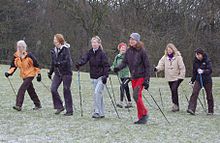(video)
Walking (also known as ambulation) is one of the main gaits of locomotion among legged animals, and is typically slower than running and other gaits. Walking is defined by an 'inverted pendulum' gait in which the body vaults over the stiff limb or limbs with each step. This applies regardless of the number of limbs - even arthropods with six, eight or more limbs.
The word walk is descended from the Old English wealcan "to roll". In humans and other bipeds, walking is generally distinguished from running in that only one foot at a time leaves contact with the ground and there is a period of double-support. In contrast, running begins when both feet are off the ground with each step. This distinction has the status of a formal requirement in competitive walking events. For quadrupedal species, there are numerous gaits which may be termed walking or running, and distinctions based upon the presence or absence of a suspended phase or the number of feet in contact any time do not yield mechanically correct classification.[1] The most effective method to distinguish walking from running is to measure the height of a person's center of mass using motion capture or a force plate at midstance. During walking, the center of mass reaches a maximum height at midstance while during running, it is at a minimum. Definitions based on the percent of the stride during which a foot is in contact with the ground (averaged across all feet) of greater than 50% contact corresponds well with identification of 'inverted pendulum' mechanics and are indicative of walking for animals with any number of limbs, although this definition is incomplete.[1] Running humans and animals may have contact periods greater than 50% of a gait cycle when rounding corners, running uphill or carrying loads.
Although walking speeds can vary greatly depending on factors such as height, weight, age, terrain, surface, load, culture, effort, and fitness, the average human walking speed is about 5.0 kilometres per hour (km/h), or about 3.1 miles per hour (mph). Specific studies have found pedestrian walking speeds ranging from 4.51 kilometres per hour (2.80 mph) to 4.75 kilometres per hour (2.95 mph) for older individuals and from 5.32 kilometres per hour (3.31 mph) to 5.43 kilometres per hour (3.37 mph) for younger individuals; a brisk walking speed can be around 6.5 kilometres per hour (4.0 mph). Champion racewalkers can average more than 14 kilometres per hour (8.7 mph) over a distance of 20 kilometres (12 mi). An average human child achieves independent walking ability around 11 months old.
Variants of walking
While not strictly bipedal, several primarily bipedal human gaits (where the long bones of the arms support at most a small fraction of the body's weight) are generally regarded as variants of walking. These include:
- Hand walking; an unusual form of locomotion, in which the walker moves primarily using their hands.
- Walking on crutches (with a variety of possible gaits);
- Walking with one or two walking stick(s) or trekking poles (reducing the load on one or both legs, or supplementing the body's normal balancingmechanisms by also pushing against the ground through at least one arm that holds a long object);
- Walking while holding on to a walker, a framework to aid with balance; and
- Scrambling, using the arms (and hands or some other extension to the arms) not just as a backup to normal balance, but, as when walking ontalus, to achieve states of balance that would be impossible or unstable when supported solely by the legs.
- Nordic walking, walking with ski poles in both hands.

